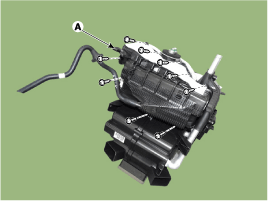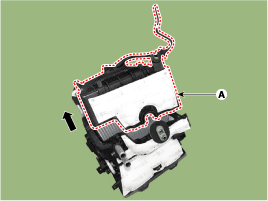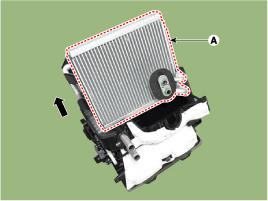Hyundai Elantra: Heater / Evaporator Core Repair procedures
Hyundai Elantra AD (2016-2020) Service Manual / Heating, Ventilation and Air Conditioning / Heater / Evaporator Core Repair procedures
| Replacement |
| 1. |
Disconnect the negative (-) battery terminal. |
| 2. |
Remove the heater and blower assembly.
(Refer to Heater - "Heater Unit") |
| 3. |
Remove the heater unit lower case (A) after loosening the mounting screws.
|
| 4. |
Pull out the evaporator core (A) from the heater unit.
|
| 5. |
To intall, reverse the removal procedure.
|
 PTC Heater Repair procedures
PTC Heater Repair procedures
Inspection
Operating Logic Test (Manual only)
Inspect the PTC operation by confirmation logic as follows.
1.
Entering
(1)
Set the Floor mode and maximum heating position.
(2)
Turn off the ...
 Temperature Control Actuator Components and Components Location
Temperature Control Actuator Components and Components Location
Components Location
1. Temperature control actuator [LH]2. Temperature control actuator [RH]
...
Other information:
Hyundai Elantra AD (2016-2020) Service Manual: Front Seat Shield Outer Cover Components and Components Location
Component Location
1. Front seat shield outer cover
...
Hyundai Elantra AD (2016-2020) Service Manual: Blower Unit Components and Components Location
Component Location
1. Blower unit assembly
Components
1. Seal2. Intake duct case3. Intake actuator4. Intake door5. Intake duct case [A]6. Air filter cover7. Air filter8. Blower unit pad9. Blower upper case10. Cluster ionizer11. Blower lower case12. Power mosfet13. Resistor14. Blower moto ...
В© 2018-2025 www.helantraad.com



